What is it chronic license plate psoriasis?
Chronic plaque psoriasis is the most common presentation of psoriasis. It comes as small to large, well-demarcated, Red, scaly and thickened areas of the skin. It is most likely to affect the elbows, knees, and lower back, but it can arise anywhere on the body.
It tends to be a relatively persistent or chronic pattern of psoriasis that can improve with treatment, but is difficult to completely eliminate with current treatments alone. It is characterized by large flat areas (plates) of psoriasis with a typical silvery scale. These plaques can coalesce to involve very large areas of skin, particularly on the trunk and extremities. It is often accompanied by scalp and nail psoriasis.
Types of chronic plaque psoriasis
Most cases of plaque psoriasis are described as “big plaque” or “small plaque” psoriasis. The plates can be located (eg, elbows and knees) or generalized (involving scalp, trunk and extremities).
Large plaque psoriasis
Large plaque psoriasis describes thick, well-demarcated red plaques with a silvery scale. This type of psoriasis often has an early onset (<40 años) y puede estar asociado con metabolismo syndrome. There is often a family history of psoriasis. It can be quite resistant to treatment.
Large plaque psoriasis

plaque psoriasis
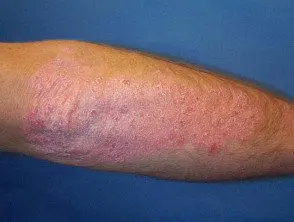
Large plaque psoriasis
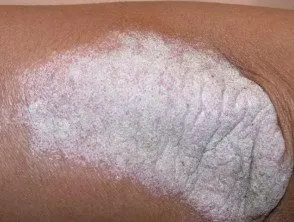
Psoriasis
small plaque psoriasis
Small plaque psoriasis often presents with numerous lesions a few millimeters to a few centimeters in diameter. The plates are thinner, pinkish in color and have a fine scale. They may be well defined or merge with the surrounding skin. Family history is less common. Although it can occur at any age, small plaque psoriasis often occurs in people over the age of 40. This type of psoriasis often responds well to phototherapy.
small plaque psoriasis
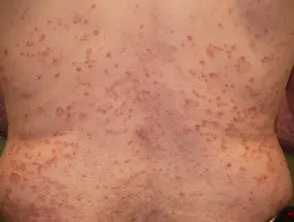
small plaque psoriasis
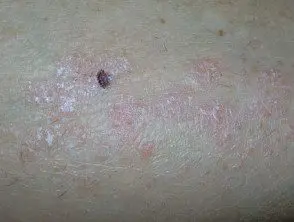
small plaque psoriasis
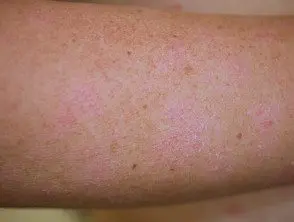
small plaque psoriasis
Other types of plaque psoriasis
Uncommon subtypes or descriptions of chronic plaque psoriasis include:
- Rupee psoriasis: limpet-like cone-shaped hyperkeratotic psoriasis lesions
- Lichenified psoriasis: areas of psoriasis that have been chronically rubbed or scratched and have become very thick
- Elephantine psoriasis: very persistent, very thick, large areas of psoriasis
- Rough psoriasis: ring-shaped areas of psoriasis with very thick scales, resembling an oyster shell
- Linear psoriasis: psoriasis arranged in lines along the body (often corresponding to lines of fetal development)
- koebnerised psoriasis: psoriasis that develops within one area of skin trauma like injuries, infection, a surgical wound or a scratch mark.
- Photosensitive psoriasis: psoriasis worse on sun-exposed areas of the face, neck, hands, and forearms. Most psoriasis patients find ultraviolet light very helpful for their psoriasis. A small group experience exacerbations from them eruption after sun exposure. Clear 'sunburn' lines are sometimes seen in these people. They may also have typical plaque psoriasis in other places. Strict sun protection, usually in combination with another treatment, is required to control This type of psoriasis.
Uncommon forms of plaque psoriasis.
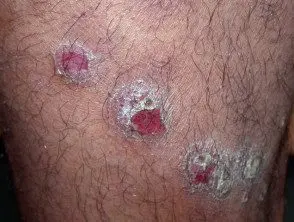
lichenified psoriasis
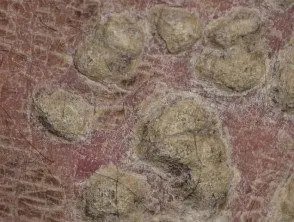
ostraceous psoriasis
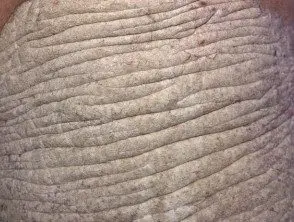
elephantine psoriasis
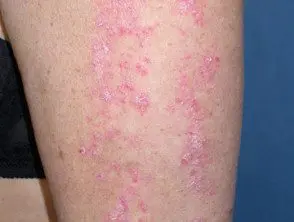
linear psoriasis
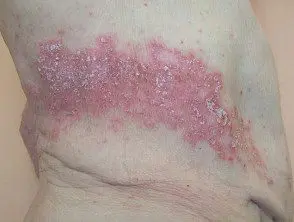
Koebnerized Psoriasis

photosensitive psoriasis
See more images of plaque psoriasis.
Evaluation of plaque psoriasis
Patients with chronic plaque psoriasis should be evaluated by a dermatologist. Factors considered may include the following:
- Age of onset of psoriasis.
- current age and sex
- Sites affected by psoriasis
- Symptoms (itching, pain)
- The categorization of psoriasis (localized or generalized, large plaque or small plaque)
- Extent and severity of psoriasis (often due to PASI punctuation)
- Functional impairment or disability due to skin disease (often using DLQI or Dermatology Quality of life index score)
- Health problems including blood pressure, weight, and body mass index (BMI)
- Smoking and alcohol consumption.
- Current medications for psoriasis and other conditions.
- Previous treatments and their effect.
- Skin phototype
- suitability of systemic therapy.
Patients being treated with systemic therapy will be asked to undergo screening tests to ensure that the drug is safe for them and how base.
Treatment of chronic plaque psoriasis.
Mild or localized chronic plaque psoriasis is usually managed initially with one or more topical agents. The following agents are usually effective for plaque psoriasis:
- Topical steroids
- Coal tar
- Dithranol
- Calcipotriol
- Combinations, such as calcipotriol/betamethasone propionate foam.
If plaque psoriasis is too extensive or severe to be effectively managed with topical treatments alone, phototherapy or systemic agents can be used and are generally very effective in improving or even eliminating the psoriasis; These include:
- Methotrexate
- Acitretin
- Cyclosporine
- Mycophenolate
-
Biologics including adalimumab, etanercept, infliximab, and ustekinumab.
For more information on these and other treatments, see the DermNet page on psoriasis treatment.

